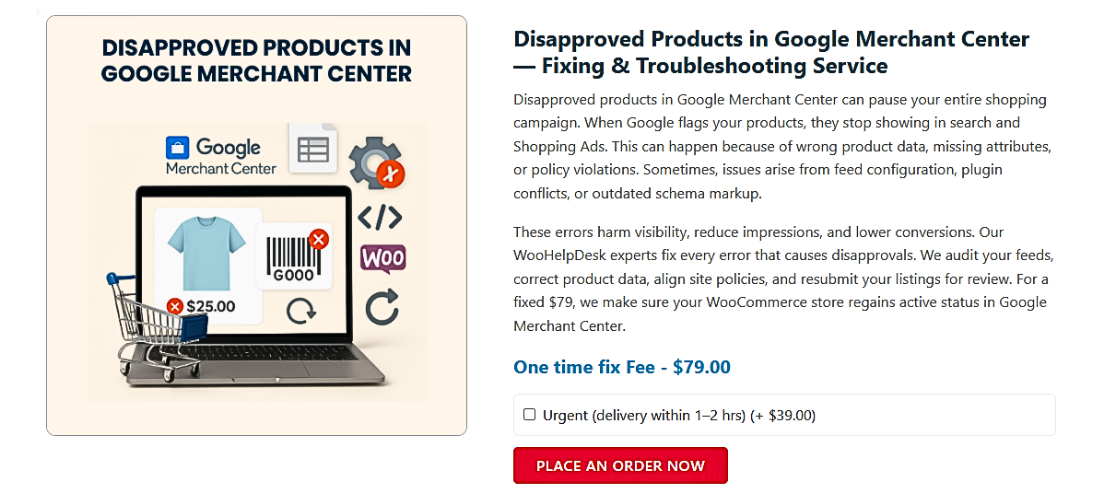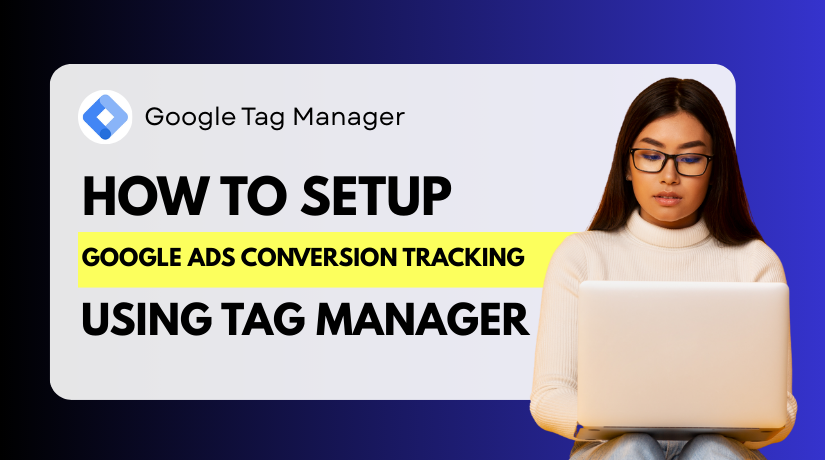
How to Fix Missing Product Attributes in Google Merchant Center
Table of Contents
- Introduction
- Importance of Product Attributes
- Understanding Product Attributes in Google Merchant Center
- Common Causes of Missing Product Attributes
- How to Fix Missing Product Attributes
- How to Prevent Attribute Issues in the Future
- Troubleshooting Attribute Disapprovals in Merchant Center
- Conclusion
Introduction
Through the Google Merchant Center (GMC) infrastructure, online merchants can submit product information to Google and make it accessible through Google Shopping Ads. Businesses that wish to use Google Search to directly display their items to prospective clients must do this. Google Merchant Center helps ensure that your products are visible when shoppers search for them.
Accurate product data is one of the most important requirements for success in Google Merchant Center. This data includes product attributes such as price, availability, and descriptions. These attributes help Google understand what products you’re selling, and in turn, display them in the most relevant search results. If the attributes are incorrect or missing, your products may not appear in searches, or worse, be disapproved by Google.
Importance of Product Attributes
Product attributes are essential details that describe your products. These characteristics aid Google in comprehending your product offerings and presenting them to the appropriate audience. Providing accurate and comprehensive attributes guarantees that your products show up in relevant Google Shopping results. If attributes are missing or incorrect, your products may not be shown or could face disapproval.
These are the key product attributes required for Google Merchant Center:
- Title: The product name that should clearly describe the item.
- Description: A brief but informative explanation of the product’s features and uses.
- Price: The cost of the product, including any applicable taxes or shipping charges.
- Availability: Whether the product is in stock, out of stock, or on backorder.
- Brand: The manufacturer or brand name of the product.
- Product Category: The category your product belongs to (e.g., electronics, clothing, etc.).
- Condition: Whether the product is new, used, or refurbished.
- GTIN (Global Trade Item Number): A unique identifier like a UPC or ISBN for the product.
- MPN (Manufacturer Part Number): A unique identifier provided by the manufacturer.
- Shipping Information: The cost and details about how the product will be shipped.
- Item ID: A unique identifier you assign to each product in your feed.
- Product Type: A custom label or category that you assign to your products.
- Tax Information: Information about how taxes apply to your products.
- Color: The color of the product.
- Size: The size of the product, such as small, medium, or large.
- Material: The materials used to make the product (e.g., cotton, leather).
- Gender: The target gender for the product (e.g., male, female, unisex).
- Age Group: The age group the product is intended for (e.g., adult, child).
- Custom Labels: Custom tags you can use for product sorting, like seasonal or promotional items.
If any of these attributes are missing, incomplete, or inaccurate, your products might be disapproved in Google Merchant Center. Providing the correct information for each attribute not only helps prevent errors but also ensures your products are shown to the right audience, maximizing their visibility and performance in Google Shopping Ads.
Understanding Product Attributes in Google Merchant Center
Google Merchant Center (GMC) relies on product attributes to understand what you’re selling and ensure your products show up correctly on Google Shopping Ads. These attributes provide Google with all the necessary details about your products, helping it match your listings to relevant search queries. If your product attributes are missing or incorrect, it can lead to product disapprovals or poor ad performance.
What Are Product Attributes?
The features or specifics that define your products are called product attributes. These can include basic information such as the product’s name, description, price, and other specific details like size, color, or brand. When a potential consumer searches for products similar to yours, Google uses this information to show your products to them.
Some key product attributes are:
- Title: A clear and accurate product name.
- Description: A brief summary of the product.
- Price: The product’s cost.
- Availability: Whether the product is in stock.
- Brand: The product’s manufacturer or brand.
Your products are more likely to show up in relevant Google Shopping searches when these attributes are submitted accurately.
How Attributes Affect Google Shopping Ads
Google uses these attributes to determine the relevance of your products to customer searches. When customers search for a specific item, Google checks the product attributes to match their query with the most relevant products. If your product feed lacks important attributes, Google might not show your product to potential buyers, even if they are looking for something similar.
For example, if you are selling a red T-shirt and the color attribute is missing, Google may not display your product in search results for “red T-shirt.” This makes it crucial to include accurate and detailed attributes in your feed.
Common Causes of Missing Product Attributes
Your products may not show up in Google Shopping Ads if you have missing product attributes in Google Merchant Center, which may result in errors or disapprovals. There are several reasons why attributes might be missing or incorrectly entered. The first step in fixing any problems is to comprehend these reasons.
- Incomplete Data in Product Feeds
One of the most common causes of missing attributes is incomplete information in your product feed. When uploading your feed, some product attributes may be left blank or skipped. This may occur for a number of reasons:
- Manual data entry errors: When adding products manually, it’s easy to overlook certain attributes.
- Feed integration issues: If you’re using third-party tools or e-commerce platforms, errors in feed integration can lead to missing attributes.
If your feed doesn’t contain all required attributes, your products will likely be disapproved or won’t show up in relevant searches.
- Incorrect Mapping or Formatting
Another common issue arises from the incorrect mapping or formatting of product attributes. Google Merchant Center expects product data in a specific format. If the format is wrong, your products may not be processed correctly. Some common mapping issues include:
- Price format errors: For example, using a currency symbol instead of a numeric value or not using a proper decimal.
- Size or color mismatch: Google expects specific terms for attributes like size and color. Using “L” instead of “Large” or “Red” instead of “Crimson” could lead to errors.
- Wrong units for shipping costs or weights: Google requires units like “lbs” or “kg” to be formatted properly.
If your attributes aren’t formatted correctly, Google won’t be able to match your products to relevant searches.
- Recent Changes in Google’s Product Data Requirements
Google frequently updates its product data requirements, which can lead to missing attributes in your feed. These changes can affect the way data should be submitted, leading to product disapprovals. Examples of these changes include:
- New required attributes: Google may introduce new attributes like “promotion details” or “identifier exists,” which your feed might not be prepared for.
- Policy changes: Google occasionally updates policies around what is considered acceptable product data. For example, a previous attribute might no longer be valid, leading to an error.
Not keeping up with these updates could result in missing or incorrect attributes, impacting your product visibility.
- Issues with Product Variants
It’s simple to overlook important characteristics for every variation of your products if they come in varied sizes, colors, or materials. Each product variant requires specific attributes that might not be shared across all variants. For example:
- Missing size or color: For a T-shirt with multiple sizes and colors, each variation needs a specific size and color attribute. If you forget to include this information for one variant, it can cause issues.
- Incorrect SKU for each variant: Every variant needs a unique SKU. If you use the same SKU for different variations, it can create confusion and lead to missing attributes for some of them.
These issues can affect product visibility and may cause disapprovals for specific variants in your feed.
- Data Feed Errors from External Sources
Sometimes, product attribute issues arise from data sources outside your control. This happens if your product feed is pulled from external sources like suppliers or manufacturers who provide incomplete or incorrect data. Common problems from external data sources include:
- Missing or outdated product information: Suppliers may not provide up-to-date data on attributes like availability, pricing, or product condition.
- Inconsistent data formats: External sources may provide product data in formats not compatible with Google Merchant Center, leading to errors.
These issues can make it hard to keep your product data accurate and compliant with Google’s requirements.
- Lack of Automation and Monitoring
A lack of automated processes or monitoring can also contribute to missing attributes. Without an automated feed update system, you may miss product changes or updates in real time. Common causes include:
- Manual feed management: Without an automated system, it’s easy to miss updates, leading to missing attributes.
- Not monitoring diagnostics: Google Merchant Center offers a “Diagnostics” section where you can find errors in your feed. Not regularly checking this can cause missing attributes to go unnoticed.
Not having proper monitoring or automated processes can lead to prolonged periods where your products are missing critical attributes.
- User or Team Errors
In many cases, user or team errors lead to missing attributes. If different people or teams are managing product feeds, it’s easy to overlook certain attributes. Common human errors include:
- Data entry mistakes: Misplaced commas, incorrect product identifiers, or forgotten attributes can cause feed issues.
- Lack of consistency: Errors may result from different team members using different terminology or formats for the same attributes.
Human errors are a major cause of missing product attributes and can often be avoided with better training or systems in place.

How to Fix Missing Product Attributes
Fixing missing product attributes in Google Merchant Center is a crucial step for ensuring your products appear in Google Shopping Ads. If certain attributes are missing or incorrect, it can lead to disapprovals, lower visibility, and ultimately, fewer sales. The following sections explain how you can address common causes of missing attributes. However, this part focuses solely on identifying the problems. Solutions for fixing these issues will be covered separately.
Step 1: Accessing Google Merchant Center Account
The first step to fixing missing attributes is to access your Google Merchant Center account. You must use your Google login information to access your account in order to accomplish this. You will be taken to your GMC dashboard after logging in.
- Dashboard Overview: You may see a summary of the health of your account on the dashboard. Here, you can find notifications about missing attributes and errors in your product feed.
- Diagnostics Tab: Google Merchant Center provides a “Diagnostics” tab, which is where you’ll find product feed issues. This section lists all errors, including missing or incorrect attributes, and is a key area for troubleshooting.
- Notifications: The system will send you notifications about missing attributes. This is where you’ll be alerted when there are issues with your feed that need attention.
If you do not regularly monitor the Google Merchant Center dashboard, missing attributes can go unnoticed. Therefore, it is essential to check your GMC account frequently.
Step 2: Identify Missing Attributes
Once you have accessed the “Diagnostics” tab, you can begin identifying which attributes are missing or incomplete in your product feed. Google will often provide detailed information about the specific attributes causing the issues.
- Error Alerts: Google will provide alerts for each product with missing attributes. For example, you might receive an error saying, “Missing required attribute: Price.”
- Detailed Product Information: Click on each alert to get a deeper insight into the product causing the error. The details will show you which attribute is missing, such as title, description, or product category.
Finding the missing qualities is the first step in resolving the problem. You can fix any issues more quickly if you check for missing attributes more often.
Step 3: Check for Missing Product Feed Data
A primary cause of missing attributes is incomplete data in your product feed. This often happens when data entry is done manually or when your feed is not properly integrated with your e-commerce platform.
- Manual Data Entry: If you’re adding products manually to Google Merchant Center, it’s easy to skip or overlook attributes. Missing data can occur if you forget to input vital product information like price, availability, or product type.
- Feed Integration Issues: If you’re using an external platform (like Shopify, WooCommerce, or Magento) to manage your product feed, sometimes the integration may fail to send complete data to Google Merchant Center. This can lead to inaccurate or missing attributes.
- Data Import Errors: Sometimes, when importing product data from suppliers or manufacturers, incomplete product data can lead to missing attributes.
To prevent missing attributes, it is important to regularly check your feed for completeness, especially if you’re using third-party tools or automated systems.
Step 4: Check for Incorrect Mapping or Formatting
Incorrect mapping or formatting is another major cause of missing attributes. Google Merchant Center requires product data in specific formats, and failing to adhere to these formats can lead to errors in your feed. Some common issues related to incorrect mapping or formatting include:
- Price Formatting: Google requires the price to be listed as a numeric value, and you must use a decimal point. For example, “$10” or “10.00” is correct, but “ten dollars” or “10$” will cause errors.
- Shipping Cost Errors: If the shipping cost is not formatted correctly or is missing, your feed may be disapproved.
- Product Identifiers: For certain products, Google requires unique identifiers such as GTIN (Global Trade Item Number) or MPN (Manufacturer Part Number). If these are missing or incorrectly mapped, the product will be flagged.
- Category or Type Errors: The product category should align with Google’s predefined categories. If there is any mismatch, your product could be disapproved.
Incorrect mapping or formatting can prevent Google from understanding your product data, leading to missing or incomplete attributes.
Step 5: Check for Missing Product Identifiers
Product identifiers like GTIN, MPN, or brand are critical to Google Merchant Center. If these identifiers are missing or incorrect, Google might not display your products correctly.
- GTIN (Global Trade Item Number): This unique product identifier helps Google match your product with search queries. Missing or incorrect GTINs can cause product errors.
- MPN (Manufacturer Part Number): For products that don’t have a GTIN, the MPN is required. If it is missing or incorrect, it could lead to missing attributes.
- Brand: If the brand attribute is missing or incorrect, your product may not be accepted in Google Shopping.
Google requires these identifiers to ensure products are accurately matched to search queries. Missing or incorrect identifiers can directly lead to product disapprovals.
Step 6: Check for Issues with Product Variants
If your products come in different variants, such as size, color, or material, it’s important to ensure that each variant has the correct attributes. Missing attributes for product variants is a common issue.
- Size: Products like clothing or shoes need a specific size attribute. If this is missing, your product feed may have errors.
- Color: Products like clothing or electronics often have a color attribute. If this attribute is missing, Google may not display your product correctly.
- Material: For items like furniture or clothing, material details (e.g., cotton, leather) are necessary. Missing material attributes can cause disapprovals.
Each variant of a product needs to have accurate attributes for size, color, and material. If one variant is missing critical information, it could lead to errors for that specific product or all variants.
Step 7: External Data Feed Errors
Many online retailers rely on external data sources, such as suppliers or manufacturers, to populate their product feed. If these sources provide incorrect or incomplete information, it can result in missing attributes.
- Supplier Data Inaccuracies: If your supplier provides incomplete or incorrect product data, the missing attributes will show up in your feed.
- Outdated Product Information: If the supplier hasn’t updated their product information, it could lead to missing attributes in your feed.
- Inconsistent Data Formats: External data might not follow Google’s required formats, leading to mapping or formatting issues.
If you rely on external data, it’s important to regularly review the product feed to ensure the attributes are accurate and up to date.
How to Prevent Attribute Issues in the Future
Preventing missing product attributes in Google Merchant Center is essential for maintaining product visibility and avoiding errors. By implementing the right strategies, you can avoid many common issues and ensure your feed remains accurate and complete. Below are some key causes that can help prevent attribute issues in the future.
- Regular Feed Updates
One of the leading causes of missing attributes is outdated product feeds. When your product details change (e.g., price, availability, description), it’s important to update your feed accordingly. If the product information is not updated regularly, Google may flag it as missing attributes.
- Price or Availability Changes: Price drops, stock changes, or product removal need immediate feed updates.
- Product Variants: New product variations like size or color need to be included in your feed.
Failing to update the feed can lead to missing product attributes, as Google relies on accurate and current data.
- Use of Automated Tools
Manual updates can lead to human error, which is a common cause of missing attributes. Using automated tools or integrations can significantly reduce this risk. Automated systems can ensure your product feed is consistently updated with accurate and complete attributes.
- Third-Party Tools: Tools like WooCommerce or Shopify integrations automatically update product feeds.
- API Integrations: APIs can sync product data from your website to Google Merchant Center in real-time.
Without automation, there is a higher chance of missing attributes due to manual oversight.
- Monitoring Diagnostics Regularly
Failing to monitor your Google Merchant Center diagnostics can cause missing attributes to go unnoticed. Google provides a Diagnostics tab that lists all errors in your feed, including missing or incorrect attributes. If you do not regularly check this section, you may miss issues that need fixing.
- Regular Checks: Make it a habit to check the diagnostics every few days.
- Error Notifications: Google will notify you when your feed has errors, but timely attention is necessary to resolve them.
Without proactive monitoring, errors will continue to affect your product feed, leading to missing attributes.
- Clear Data Management Systems
Having an organized data management system is crucial to prevent missing attributes. If your product information is disorganized or inconsistent, it’s easy for important attributes to be overlooked.
- Consistent Format: Ensure the data is formatted correctly and consistently.
- Centralized Database: Use a single platform to manage all product details for easy updates.
Disorganization in your product data can lead to missing or inaccurate attributes being uploaded to Google Merchant Center.
Troubleshooting Attribute Disapprovals in Merchant Center
When products in your Google Merchant Center account get disapproved, it’s often due to issues with product attributes. Troubleshooting these disapprovals is crucial to ensuring your products remain visible in Google Shopping Ads. Below are common causes of attribute disapprovals and how to recognize them.
- Missing or Incorrect Product Identifiers
Product identifiers like GTIN (Global Trade Item Number) or MPN (Manufacturer Part Number) are critical for product listings. Google requires these identifiers for accurate product matching. Missing or incorrect identifiers can lead to disapproval.
- GTIN: If your product does not have a GTIN or uses an invalid one, Google will flag it.
- MPN: For products without a GTIN, the MPN is necessary. Incorrect MPNs also cause disapprovals.
Without these identifiers, your products will not meet Google’s requirements, leading to disapprovals.
- Incorrect or Missing Pricing Information
Google Merchant Center requires accurate pricing for your products. If the pricing information is missing, incorrect, or inconsistent, Google will reject the product feed.
- Price Format Errors: If the price is incorrectly formatted (e.g., using a currency symbol instead of numeric values), it will be flagged.
- Inconsistent Prices: If the price in the feed doesn’t match the price on your website, it can lead to disapproval.
- Missing Sale Prices: If you’re offering a sale, Google requires the sale price to be entered. Missing sale prices lead to errors.
Pricing errors are one of the most common reasons for disapproval and need immediate attention.
- Missing or Incorrect Availability Status
Google requires the “availability” attribute to be accurate for each product. Missing or incorrect availability information, such as showing a product as in stock when it’s out of stock, can lead to disapproval.
- Out-of-Stock Products: If you fail to mark products as out of stock, they will be disapproved.
- Inconsistent Availability: If your product’s availability status changes frequently but isn’t updated in your feed, Google may reject it.
Google uses the availability attribute to ensure users only see products that are available for purchase. Inaccurate information affects the visibility of your ads.
- Policy Violations
Google Merchant Center has strict policies regarding product listings. Violating these policies can cause attribute disapprovals, leading to product removal from the Google Shopping platform.
- Prohibited Products: Products that fall under restricted categories or violate Google’s advertising policies (e.g., counterfeit products) will be disapproved.
- Non-Compliant Data: If your data doesn’t meet Google’s content requirements or guidelines, your products will be flagged.
It is important to review Google’s policies to ensure your product data aligns with their standards.
- Missing or Inaccurate Custom Labels
Google allows you to use custom labels for better product categorization. Missing or incorrect custom labels can cause disapproval, especially if they are required for promotional campaigns or seasonal products.
- Required Custom Labels: If your product requires a custom label (e.g., “on sale,” “seasonal”), missing this label can lead to disapproval.
- Incorrect Custom Labels: Using an incorrect label for your product category can result in errors.
Custom labels help organize your products for more effective ad campaigns. Missing or incorrect labels hinder ad visibility.
Conclusion
To maintain a successful Google Shopping campaign, it’s essential to ensure your product attributes are accurate and up-to-date. By preventing errors, troubleshooting disapprovals, and keeping your feed optimized, you can maximize your visibility and sales potential. If you encounter difficulties managing your product data or need expert assistance, WooHelpDesk is here to help. With our reliable support and advanced solutions, you can streamline your Google Merchant Center setup and resolve any issues quickly. Don’t let missing or incorrect attributes hold you back. Visit WooHelpDesk.com today to access top-tier support and ensure your products shine on Google Shopping Ads.




